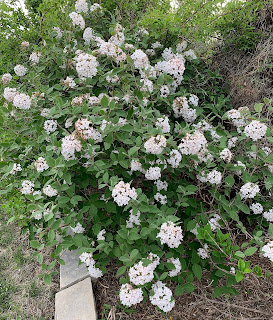 ProfessorRoush was forced into the mundane chores of garden these past two days on the prairie. Rapidly growing grass and weeds meant that I spent most of Saturday's 'free time' mowing the lawn and trimming, and most of Sunday's "free time" weeding and planting. I planted 22 garden pepper plants and 17 tomatoes. And I also replaced the watermelon and cantaloupe that I planted and previously mentioned in the Showing the Crazy blog entry. Not surprisingly, the first two didn't make it. This time I planted 'Sugar Baby' watermelon, 'Ambrosia' and 'Athena' cantaloupes.
ProfessorRoush was forced into the mundane chores of garden these past two days on the prairie. Rapidly growing grass and weeds meant that I spent most of Saturday's 'free time' mowing the lawn and trimming, and most of Sunday's "free time" weeding and planting. I planted 22 garden pepper plants and 17 tomatoes. And I also replaced the watermelon and cantaloupe that I planted and previously mentioned in the Showing the Crazy blog entry. Not surprisingly, the first two didn't make it. This time I planted 'Sugar Baby' watermelon, 'Ambrosia' and 'Athena' cantaloupes. Remember the song "Bad Moon Rising" by Creedance Clearwater Revival? Lyrics that include "I hear hurricanes a-blowing. I know the end is coming soon. I hear the rivers over flowing...There's a bad moon on the rise." Well, my 'Prairie Moon' peony is rising (upper left), and it's not a bad moon, even though the rain around here has the ground saturated and some folk in town have water in basements again. 'Prairie Moon' is just a beauty, pure white blooms as big as your outstretched hand and healthy bright green smooth foliage. What's that you say? The foliage isn't smooth? Yeah, that's a volunteer hollyhock in front of the peony that I didn't have the heart to root out. As long as it doesn't smother 'Prairie Moon', I'll let the hollyhock bloom and then grub it out later.
 Speaking of tomato planting, I had the bright idea to plant Mrs. ProfessorRoush's favorite grape-sized tomatoes in the large pots on the back (south) patio this year. They'll get major sun there if they can stand the heat. I was hand-digging a hole in the potting soil and the little gray tree frog pictured at the left about gave me a heart-attack, sitting as still as a postage stamp on the edge of the pot. I almost put my hand right on him! Here they come again, those sneaky peeping frogs, watching my every move. Creeps me out, I tell you.
Speaking of tomato planting, I had the bright idea to plant Mrs. ProfessorRoush's favorite grape-sized tomatoes in the large pots on the back (south) patio this year. They'll get major sun there if they can stand the heat. I was hand-digging a hole in the potting soil and the little gray tree frog pictured at the left about gave me a heart-attack, sitting as still as a postage stamp on the edge of the pot. I almost put my hand right on him! Here they come again, those sneaky peeping frogs, watching my every move. Creeps me out, I tell you.Bella is in the garden with me most days right now, protecting me and making sure the Texas Longhorns don't cross the barbed wire fence. There is something that just feels right about longhorns on the prairie, isn't there? Well, may not right to Bella, who seems a little disturbed by these big dumb things in her pasture.










